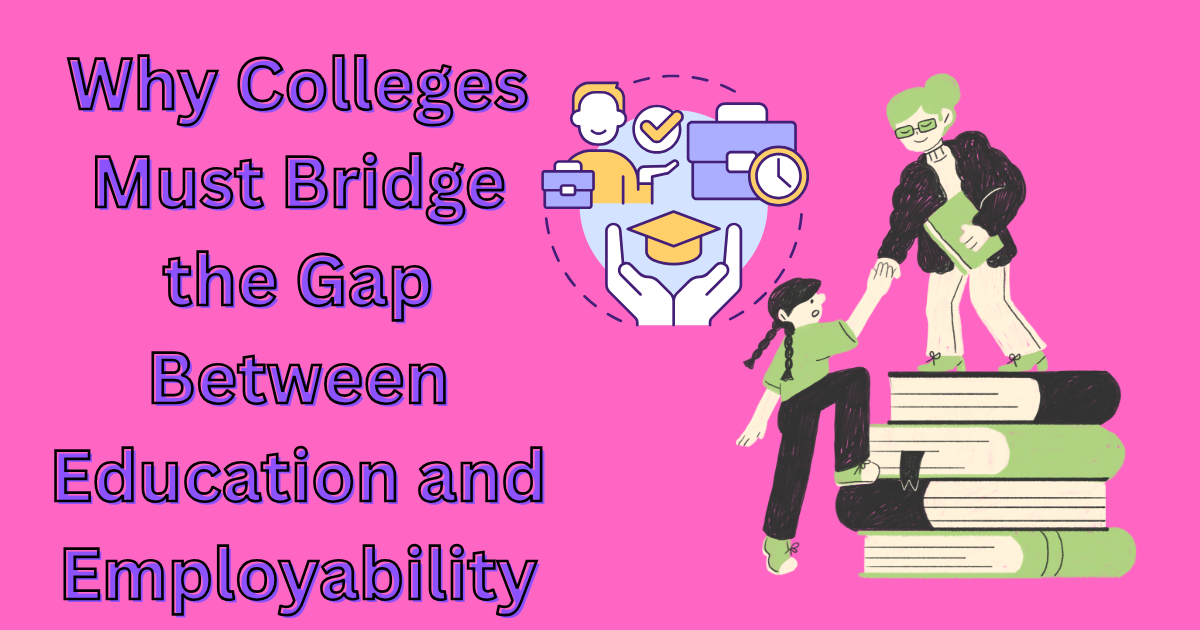Why Colleges Must Bridge the Gap Between Education and Employability: As the world developed, the gap between education and employment grew wider. To bridge this gap, educational institutions must better align academic learning with job readiness.
Why Colleges Must Bridge the Gap Between Education and Employability
The best-educated workers are prospering, but there are many others being left behind. To address this college. Community colleges can be rich resources for educating the higher-skilled workers that industry is now demanding. In The Changing Face of Community College Education, “panellists who work at community colleges discussed the growing demands for the incumbent workers training and fast-tracked entry-level workforce training.

The relationship between education and employment opportunities is undeniable. Those with access to high-quality education are positioned to secure well-paying jobs, contribute meaningfully to their communities, and drive economic growth. We must address the root cause by not only encouraging education but also providing tangible support and motivation to afford children to pursue learning.
This creates a vicious cycle where children from marginalised communities are unable to break free from poverty because they lack the education foundation necessary to secure well-paying jobs. This disparity in educational access is influenced by various factors, including resources, the learning environment, and the quality of teaching. The disparity is not just an issue for the individuals affected; it is a challenge for society as a whole. By investing in education, businesses and governments are investing in the future workforce.
Bridging the education gap is not just a matter of equity; it is a necessity for building a better future. By bringing together businesses, governments, and educational institutions, businesses, governments, and educational institutions can make sure that every child has access to the quality education they deserve. As we work towards bridging the disparity gap, it is important to remember that every child reached is a step towards a more equitable future. Mismatch by level of education: it occurs when the level of education of the person in employment does not correspond to the level of education required to perform their job.
What is the education gap?
The education gap refers to the disconnect between what students learn in colleges and what employers expect in the world. Many graduates lack hands-on experience, industry-relevant skills, and practical exposure, making them less employable despite holding degrees.
- Academic Knowledge vs. Job-Ready Skills: Universities emphasise textbooks and exams, whereas companies seek critical thinking, adaptability, and technical expertise.
Reasons of the Gap Between Education and Employment
- Outdated Curriculum: Many universities still follow traditional syllabi, which fail to cover evolving fields like AI, digital marketing and data analytics.
- Lack of practical exposure: Students who graduate with theoretical knowledge but lack internships and real-world projects.
- Mismatch Between Industry Needs and Academic Learning: Employers seek digital skills, data literacy, and critical thinking, which are often not taught in degree programmes.
- Rise of Automation and AI : With technology replacing manual jobs, new-age careers require coding, automation, and AI expertise, which many graduates lack.
- Limited Soft Skills Development: Communication, teamwork, leadership, and negotiation are essential in today’s job market, yet they aren’t emphasised in traditional education.
What can students and job seekers do?
- Skill-based Learning – Hands-on training in emerging technologies and industry-relevant skills.
- Interactive and practical training – Unlike lectures, workshops focus on active learning and real-world application.
- Exposure to Industry Experts – Direct learning from professionals helps students to understand.
- Networking Opportunities – Connections with industry leaders and potential employers boost career prospects.
- Enhancing employees’ abilities – Resume building, interview preparation, and corporate etiquette training improve job readiness.
- Specialised learning – Covers niche skills often missing from traditional academic curriculums.
- Take online course
- Gain practical Experience
- Build a strong Resume and portfolio –
- Employers value a portfolio showcasing real-world projects over just degrees.
- Develop soft skills – communication, adaptability, teamwork, and problem-solving are essential for workplace success.
Conclusion
In this article we discussed why colleges must bridge the gap between education and employability. Bridging the education gap is not just a matter of equity; it is a necessity for building a better future. As we work towards bridging the disparity gap, it is important to remember that every child reached is a step towards a more equitable future. By investing in education, businesses and governments are investing in the future workforce.
